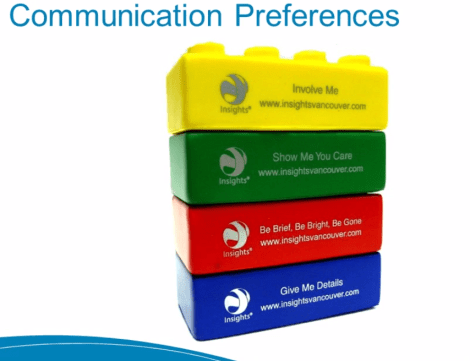Tag Archives: career coach Margaret Smith
August 7, 2019 Communication in 4 Colors (get to know Insights Discovery!)

Updated August, 2019
A Note From Margaret:
In the history of the UXL Blog (which has been active since 2011), this post is by far the most popular. That says a lot to me. For one, it means that people are interested in effective communication and developing a deeper understanding of their colleagues and co-workers. It also means that many people suspect that Insights® Discovery is a useful tool for digging in and approaching communication issues from a science-based, practical approach.
If your team is struggling with communication (whether among team members, between bosses and staff, or with clients), I can help. As an Insights® Discovery Licensed Practitioner, I offer workshops and training to individuals and teams of any size, in any industry. I invite you to contact me today for more information.
Now, on with the post…
Do you ever wonder why a certain co-worker is so quiet? Or why another co-worker always wants to work in teams? Or why another won’t make a decision until everyone’s voice has been heard?
Assessment tests, such as Insights® Discovery, can unearth the mysteries behind your co-workers’ communication tendencies. Insights® is a science-based personality test designed to help you gain a better understanding of your own and others’ behaviors, tendencies, and perspectives. As an Insights® Licensed Practitioner, I have introduced many teams to Insights® and have witnessed improved communication, better leadership, and greater team cohesion and empathy.
One of the things I like best about Insights® is its approachable model, broken down into four main color energies (blue, red, yellow, and green). The idea behind the model is that everyone has the capacity to exhibit and embrace all four distinct personality types, but we all tend to lead with or prefer a certain personality type. Here is a brief overview of each color/personality type. Which one do you immediately identify with?

RED: Those who lead with red energy tend to be assertive, bold, and to-the-point. They are natural leaders and love to take charge and make quick decisions.
YELLOW: Yellows are bright, sunshiney, and social. They love working in teams, brainstorming ideas, and connecting with new people.
GREEN: People with a strong green tendency are typically empathetic and inclusive. Above all, they care about the happiness of their team members and want to make sure all voices are heard.
BLUE: Blues are data-driven, analytical, and contemplative. They like to mull over an issue and consider all angles before making a decision.
Now that you know a little bit about each color energy, let’s hone in on communication. Each group of people–reds, yellows, blues, and greens–has a different communication preference. The image below outlines how best to approach those who lead with a certain color energy:

If you have a good hunch about someone’s leading color, take the time to stand in their shoes and consider how they might prefer to communicate. Should you be brief and bright with them (red)? Should you take the time to be social and ask about their family or weekend (yellow)? Should you ask about their emotional reaction toward a project (green)? Should you present them with a complete set of data and analysis (blue)?
This, of course, is just the tip of the Insights® Discovery iceberg. For more information on Insights®, or to find out how to acquire an assessment kit for your team, please contact me today.
MARGARET SMITH IS A CAREER COACH, AUTHOR, INSIGHTS®DISCOVERY LICENSED PRACTITIONER, FOUNDER OF UXL, AND CO-FOUNDER OF THE TAG TEAM. SHE HOSTS WORKSHOPS FOR PEOPLE WHO NEED CAREER OR PERSONAL GUIDANCE. YOU CAN VISIT HER WEBSITE AT WWW.YOUEXCELNOW.COM
Tags: benefits of Insights Discovery, business coach Margaret Smith, career advice, career coach Margaret Smith, communication and insights discovery, enhance team communication, improve communication, Insights Deeper Discovery Workshops, Insights Discovery for teams, Minnesota business coach
- 11 comments
- Posted under Communication, Insights Discovery, Teamwork, Thrive at Work
November 28, 2018 Storytelling is Your Secret Weapon

Did you hear any captivating stories as you sat around the Thanksgiving table this past week? If so, you might have noticed that the speaker used certain techniques to draw you in–vivid descriptions, facial expressions, a narrative arc. A good storyteller makes these things seem natural.
If you think about it, storytelling has A LOT of cross-application when it comes to work. In the past, I’ve discussed how it can be a powerful sales tool, but it can be useful to anyone in almost any industry. Use storytelling techniques to:
- Be a more engaging, charismatic leader
- Keep others’ attention when you’re presenting during a meeting
- Snag a new client
- Make a convincing argument or illustrate an idea
- Present a point to your team
Ok. You’re probably convinced that storytelling is useful, but it doesn’t necessarily come naturally to everyone. How do you work on developing your storytelling techniques?
1. Practice
You probably won’t be a natural storyteller at first, but the key is to PRACTICE. Think about scenarios in which storytelling might come in handy, and then make an effort to do it. Be sure to practice the story you’d like to tell beforehand–do it aloud and in front of a mirror to work out any rough patches.
2. Consider the main point
Your story can’t just be a story. It has to have some kind of relevance to the topic at hand. If, for instance, you’re trying to prove the effectiveness of a product, tell a story about how the product helped a specific person. If you’d like to demonstrate to a potential new client that your company is trustworthy, tell about a time that your team came through in a pinch.
3. Remember the classic story arc
Every good story has a beginning, middle, and end. The beginning should hook your audience, while the end should clearly give the main message and potentially be a call to action. If your story is jumbled, others will have trouble deciphering the main message or become disengaged.
4. Use a “lead-in”
It’s odd to jump straight into a story with no lead-in. You’ll want to tie the story to the topic that’s being discussed before plunging in. Frame up your story with a lead-in like one of the following:
- “I am confident product XYZ is a good value to our customers. One example that comes to mind is…”
- “I think it would be beneficial if we changed to system X. One reason is that…”
- “This reminds me of something I witnessed last year…”
- “We have to consider statistics, of course, but anecdotally, I once noticed…”
- “I’d like to give you an example of why I think X would be a good idea…”
5. Practice some more
You may not hit the nail on the head the first time you try storytelling. Keep at it and modify your techniques as need-be. Does your delivery need work? Do you need to use better vocal inflection? Are you having trouble articulating your main point?
Assess, try again, repeat. Skilled storytellers don’t develop overnight.
Need more storytelling techniques? Feel free to contact me for guidance.
MARGARET SMITH IS A CAREER COACH, AUTHOR, INSIGHTS®DISCOVERY LICENSED PRACTITIONER, FOUNDER OF UXL, AND CO-FOUNDER OF THE TAG TEAM. SHE HOSTS WORKSHOPS FOR PEOPLE WHO NEED CAREER OR PERSONAL GUIDANCE. YOU CAN VISIT HER WEBSITE AT WWW.YOUEXCELNOW.COM
Tags: career coach Margaret Smith, improve speaking skills, margaret smith leadership, Margaret Smith Minneapolis career coach, storytelling at work, storytelling in sales, the power of storytelling
- Leave a comment
- Posted under Better Business, Discussions, Thrive at Work
November 21, 2018 Finding Meaning in Work

It’s a common challenge: How do you love your job and make money? Some are lucky to achieve both, but many people feel stuck between one or the other. Unfortunately, many artistic endeavors and social services do not pay well, despite their value to society. Because of that, many people are left feeling unfulfilled in their office jobs, wondering if they should be doing something MORE with their lives.
Does that sound like you?
If so, you’re not alone. If your discontentment is severe, consider talking to a career coach (drop me a note if you’d like). If, however, your discontentment is more of a nagging tug at your conscience, you may be able to improve things on your own.
No matter what industry you’re in, there’s usually an opportunity to integrate art, altruism, community, or whatever piques your interest into your work. It only takes a little creativity, initiative, and perseverance. Start with these four steps:
1. Look For Existing Opportunities
Depending on your organization, meaningful opportunities may already exist. Some businesses have groups devoted to community projects, art, or forming connections between like-minded co-workers. Do a little research and see if anything that aligns with your interests already exists.
2. Integrate Interests With Daily Work
Interested in photography? Volunteer to take pictures for the monthly newsletter or company website. Love writing? Ask your boss for writing-heavy assignments or, if you’re working in a team, offer to take on the writing tasks. See if it’s possible to meld your interests with your everyday workload.
3. Take Initiative!
Create your own meaning by initiating groups devoted to volunteering, artistic endeavors, or other projects related to your interests. Of course, you’ll want to go through the proper channels to do this, but you might be surprised by how willing organizations can be when it comes to volunteer or enrichment programs. Chances are, other people will also be interested in your endeavor, which translates into a more tight-knit, content work community.
Some ideas for you to consider include:
- Creating an artists’ club for knitting, painting, photography, or whatever you’re interested in (Instead of a weekly happy hour, host an “art session” instead!)
- Volunteering in the local community (soup kitchens, book drives, etc.)
- Initiating fundraisers for schools, safety, health and wellness, or whatever you’d like
- Starting a “green” group that occasionally gets together to do roadside cleanups or raise money for parks, clean water, etc.
- Founding a wellness program that focuses on clean eating, meditation, weekly yoga, or whatever you’re passionate about
4. Look For Resources
Some organizations have funds set aside for “extracurricular” work activities. Do your research! Might your company be willing to sponsor your initiative? Don’t forget, people count as resources too. You may be surprised by others’ excitement and willingness to help.
Do you feel invigorated? Energized? Ready to dive in and figure out how to make work more meaningful for YOU? I hope so. Finding meaning in your work is vital for your sustained happiness.
If you’d like a little more guidance, I’m here to help.
MARGARET SMITH IS A CAREER COACH, AUTHOR, INSIGHTS®DISCOVERY LICENSED PRACTITIONER, FOUNDER OF UXL, AND CO-FOUNDER OF THE TAG TEAM. SHE HOSTS WORKSHOPS FOR PEOPLE WHO NEED CAREER OR PERSONAL GUIDANCE. YOU CAN VISIT HER WEBSITE AT WWW.YOUEXCELNOW.COM
Tags: career coach Margaret Smith, finding meaning in work, love what you do, love your work, Margaret Smith life coach, Margaret Smith Twin Cities, Meaningful work, seek meaning in career
- Leave a comment
- Posted under Advice from a Life Coach, Changing Your Life, Thrive at Work

